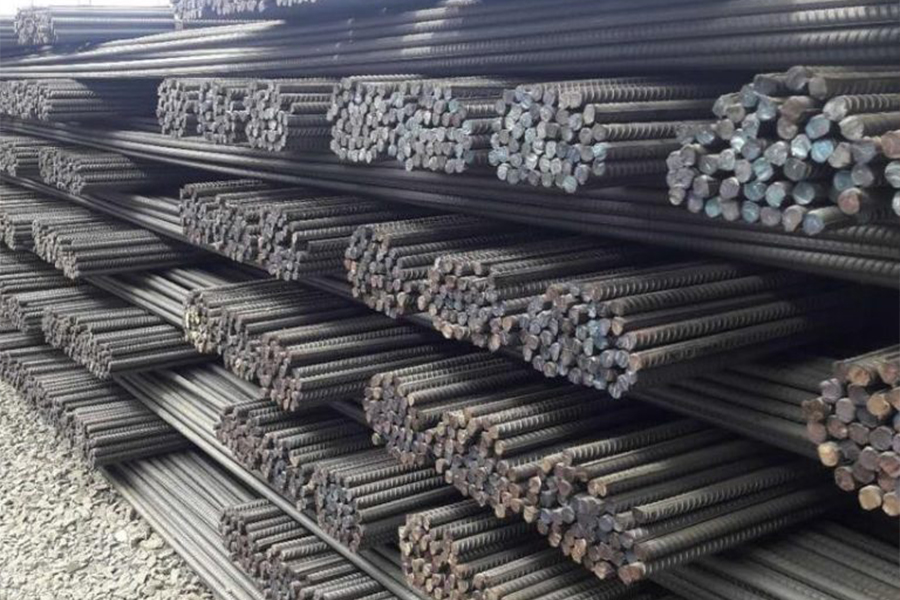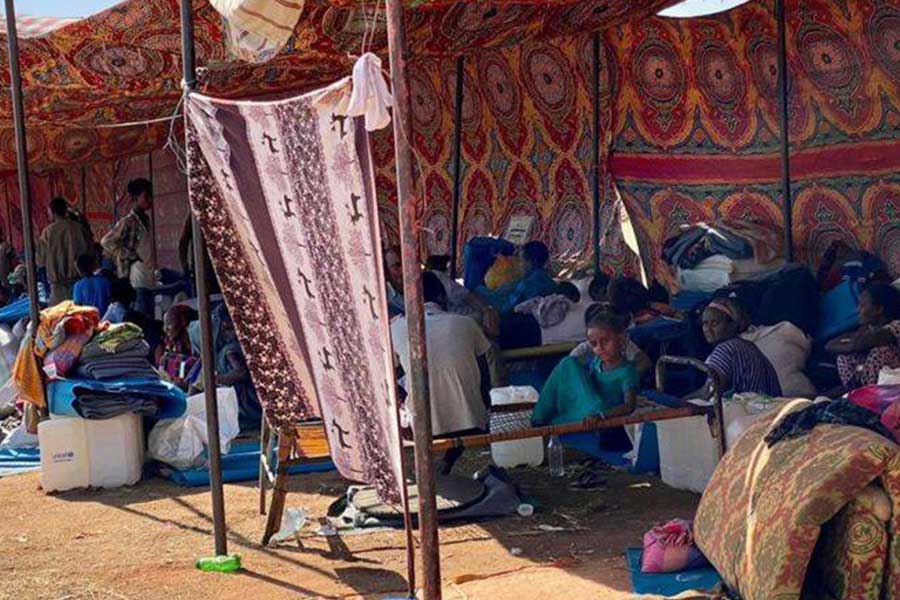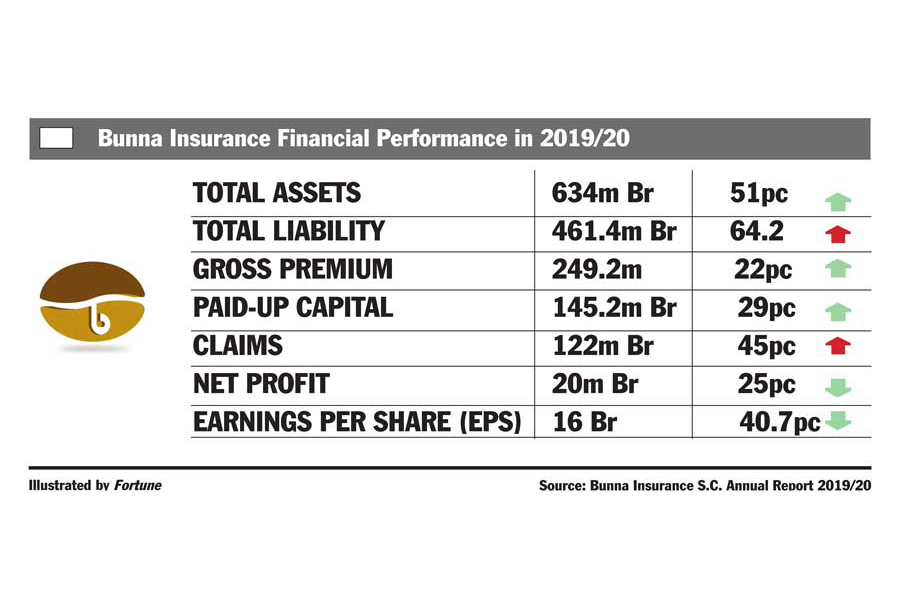
Commentaries | Jan 13,2024
A pool of stagnant rainwater is the first thing that greets someone making their way into the branch office of the Addis Abeba Housing Development Bureau located at the Bole Bulbula condominium site. A wooden slab lies in the middle of this floor, a glorified walkway amid the bits of plastic, wood and general building debris strewn around.
This walkway leads to the stairs to the first floor. Halfway through to the stairs, a small printed congratulatory post welcomes the "second round of house owners" for the middle-income housing scheme, the registration and payment for which started nearly eight years ago. At the time, over 160,000 aspiring homeowners jumped at the opportunity.
The attempt at a festive atmosphere continues to the first floor with the colourful deflated balloons hanging atop the wires coming out of the ceiling. The first floor is infinitely better than the ground floor. Here the floor is cemented, the walls painted; and though the window panes do not have glass in them yet, there is a general sense of order.
A few tables and chairs are spaced out in the room for these lucky winners. One officer from the Bureau is assigned to sort the necessary paperwork. This is where Daniel Abebe has been coming to sort out the ever-continuing issues with his home.
When he found out that his name had been drawn out of a raffle for close to 60,000 other people over a year ago, he was ecstatic.
"I didn't know how to contain my happiness," he said. "I thought I was finally a homeowner after 15 years of renting."
Daniel was in disbelief for many reasons. For one, when he had started saving up for the housing scheme, there were over 140,000 others along with him that put their name in. The housing scheme, divided up into middle, lower-middle and low-income tiers, was simple enough when it started out in 2013, but its execution over the years has been anything but.
The idea was brought up as a solution to the ever-growing demand for housing in the city. Low and middle-income segments of society were targeted through this programme that would enable them to save up a certain percentage, while the rest would be financed through the Commercial Bank of Ethiopia (CBE).
Aspiring homeowners are required to save 40pc, 20pc or 10pc, depending on the level of income, of the total cost of a government-subsidised home; and after depositing the allotted percentage, ranging from a studio-style to a three-bedroom apartment, they partake in a raffle drawing. The lucky ones get to receive the first finished houses, while the remaining wait for the next round.
The first round of the middle-income housing scheme a few years back handed over only 1,200 homes. Last year, close to 19,000 individual winners of the second round of the raffle were announced.
"We were told that the houses would be ready in three years time when we registered for the programme," said Daniel. "Seven years later, our homes don't even have electric or water lines in place."
Condominium blocks in Bole Beshale are still at a very early stage of construction.
At the time, Daniel was informed that his condominium, located in Bole Bulbula, would soon be ready, and he would have to take all the necessary legal steps until then. Paperwork was aplenty.
Providing documents authenticating that he had been saving the required amount over the years from the Bank and another form from his kebele verifying that he did not own a house already were the initial steps. Following that, he signed a loan agreement with the CBE for the remaining 60pc of the payment for his house.
When Daniel registered for this home, he was expected to pay around 168,000 Br in total for his one-bedroom condominium. By the time he signed the agreement with the Bank, it had grown to nearly half a million Birr.
"Inflation was the reason that we were given," he said. "But the reasons for the delay itself matter more than that."
Administration mandate issues between the CBE and the City Administration on the management of the houses had also taken time to resolve, he was told.
The contractors were another issue.
"We've had so many contractors change over the past few years, and this has caused the delay," he said. "The one we are told to communicate with now was signed onto this project a few weeks back."
But eager to get a house after waiting for so many years, Daniel signed the necessary contract with the Bank. The house deeds were passed onto the Bank as collateral until he repaid his loans, and he was informed by the Office that he would be called to get the keys to his home very soon. The clock on the interest for his bank payments was wound up and set to go. The condominiums, however, were far from ready.
"We lobbied the Bank to give us a grace period when we knew our homes weren't ready," he said. "Eventually, we were granted a year's time."
This was in May 2019. Now homeowners like Daniel have not only finished their one-year grace period but an additional three months in consideration of the impact of the Novel Coronavirus pandemic (COVID-19). The loan from the Bank along with the interest payments have since then been compounding.
"I've been paying rent for my house," he said. "And now I have an additional loan to pay for a house I don't even live in."
His house, like many others in Bole Bulbula, is not ready. While the buildings have been painted and the window panes look in place to the outside onlooker, their insides tell a different story. Water, sewage systems and electrical lines are not in place, just concrete structures outlining a potential home.
This rings true for other middle-income condominiums deemed ready across the city. In the Bole Beshale site, there are 53 towering condominium blocks with over 6,000 units. Guards are stationed every few blocks protecting items like rebar and electrical wiring from thieves. The houses here were also part of the raffle in February 2019. They make up part of the 38,000 units under construction in the city under the same scheme.
Here, like other sites, homeowners who have paid in full for their homes are left only with similar structures. Dagmawi Gebre had been living in Germany when he found out he, too, was one of the lucky ones.
He had wanted to finalise the process through family members but was informed that would not be possible. He packed his bags and came straight away, naively thinking that the arrangement would not take more than a few week's time to finalise.
"It took me about five months to get the deed to my apartment," he said. "This was after paying the remaining 60pc of the house."
The worst part was waiting in line for hours every day for almost two weeks at the City Administration office, turning in one document after the other, according to him. And now, a year later, his house is still only cement walls and a standing structure on the second floor of a skeleton building.
The low-income and lower-middle-income schemes for which over 700,000 people have registered has followed a different trajectory.
The low-income programme, in which homebuyers raise 10pc of the condominium price, hve all been provided for as far as the data from the authorities show. About 23,000 people had registered, and 24,000 units of housing were built. The chapter there was closed.
The lower-middle-income housing scheme, for which participants were expected to save 20pc of the total cost of their house, had initially absorbed another set of registrants. The first-ever housing scheme in 2004, which registered close to half a million people, introduced the concept of condominium housing to the country. When the two schemes were integrated, a recount showed over 800,000 were saving for the homes.
To date, only 276,502 houses have been handed over to people under this scheme. And close to 50,000 remain from the registration 16 years ago.
The list goes on. Condominium sites are scattered from Bole Beshale on the outskirts of the city to the central ones in Megenagna and near Haya Arat, all of which are towering buildings waiting to be finished.
It is not that homeowners have not voiced their concerns. But questions of how and even to whom has posed a problem. The responsibility of the homes, previously under the Addis Abeba Housing Development Project Office, has been handed over to the Addis Abeba Housing Development Corporation. The latter is now working alongside three other offices under the wings of the Addis Abeba Housing Development Administration Bureau, which has been reshuffled more times than the homeowners can keep track of.
"It's all very confusing," said Daniel, who is now actively working with a few others to assemble an association. "There's someone new every time who says they are not familiar with our case."
Desalegn Terefe, director of the Housing Development Corporation, says that it is up to the City Administration to answer any question on the housing scheme, while Senait Damtew, bureau head of the Addis Abeba Housing Development Administration, did not respond to the phone call and text message from Fortune.
Contractors working on the project, over 2,000 of them, state multiple reasons for this crisis. One contractor who chose to remain anonymous stated that finance and necessary inputs for the project were lacking.
"Getting payment approved for one process requires visiting and getting signatures from multiple offices," he said. "This is in addition to having a shortage of cement blocks, sand, and other materials, as the government is responsible for providing this for us."
That there are more houses being built and that it is focused on vertical growth, with consideration to space limitations, is commendable, according to Zegeye Cherinet (PhD), head of competence at the Centre of Architecture & Design under the Ethiopian Institute of Architecture, Building Construction & City Development.
But the country's lack of experience in urban planning development cannot be overlooked as the original source for this mess, according to him.
"With 80pc of the population living in rural areas, we don't have the institutions or the experience to implement a successful urban planning and housing plan," he said.
But realising this and working on the capacity of the country is the first step the expert advised. This begins with crafting a housing policy, according to him.
"It's much like health, education and other important sectors, as housing is a basic and constitutional right," he said. "Following this should be relevant strategies and plans for housing."
Urbanisation and modernisation are intrinsically intertwined, and this requires not only working toward increased technical competence but also raising the consciousness of the population on how to live in urban areas, according to him.
PUBLISHED ON
Aug 29,2020 [ VOL
21 , NO
1061]

Commentaries | Jan 13,2024

Editorial | Jun 12,2021

Viewpoints | Nov 02,2024

Editorial | Sep 02,2023

Fortune News | Nov 11,2023

Fortune News | Nov 21,2020

Viewpoints | Jul 03,2021

Radar | Dec 14,2019

Fortune News | Nov 29,2020

Viewpoints | Sep 14,2024

Dec 22 , 2024 . By TIZITA SHEWAFERAW
Charged with transforming colossal state-owned enterprises into modern and competitiv...

Aug 18 , 2024 . By AKSAH ITALO
Although predictable Yonas Zerihun's job in the ride-hailing service is not immune to...

Jul 28 , 2024 . By TIZITA SHEWAFERAW
Unhabitual, perhaps too many, Samuel Gebreyohannes, 38, used to occasionally enjoy a couple of beers at breakfast. However, he recently swit...

Jul 13 , 2024 . By AKSAH ITALO
Investors who rely on tractors, trucks, and field vehicles for commuting, transporting commodities, and f...

Jun 28 , 2025
Meseret Damtie, the assertive auditor general, has never been shy about naming names...

Jun 21 , 2025
A well-worn adage says, “Budget is not destiny, but it is direction.” Examining t...

Jun 14 , 2025
Yet again, the Horn of Africa is bracing for trouble. A region already frayed by wars...

Jun 7 , 2025
Few promises shine brighter in Addis Abeba than the pledge of a roof for every family...